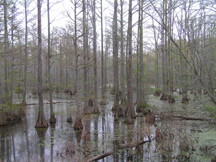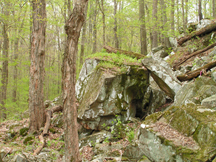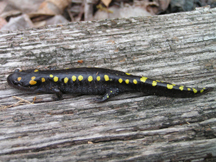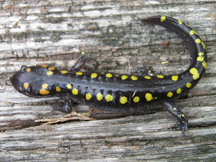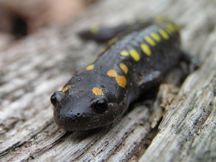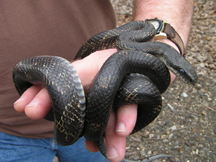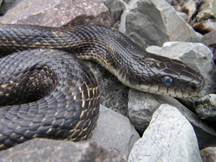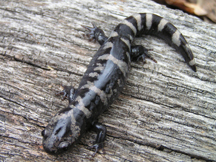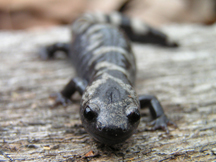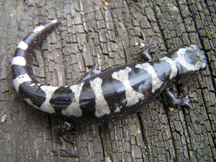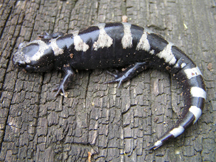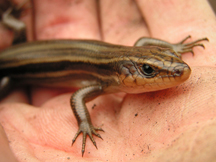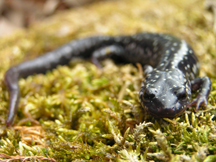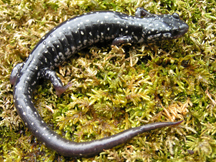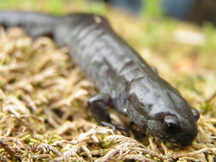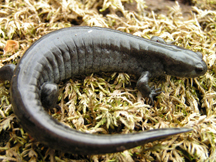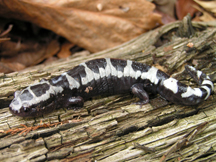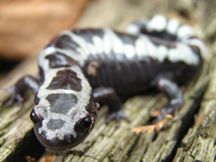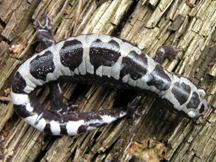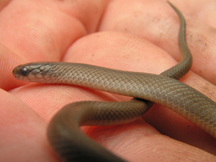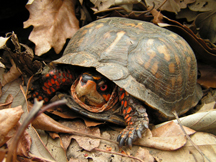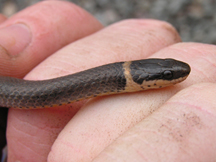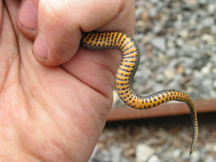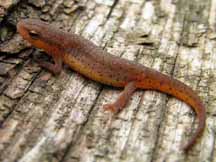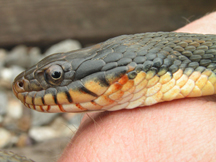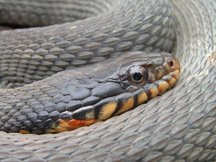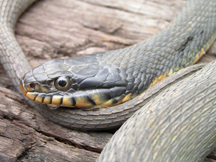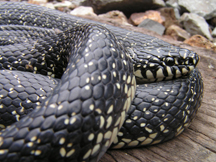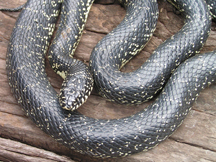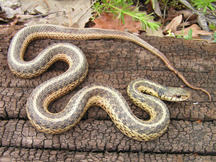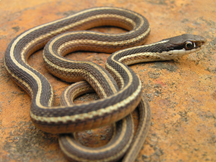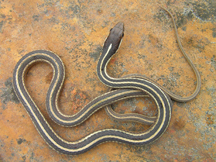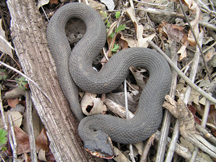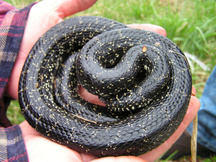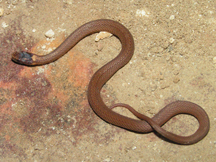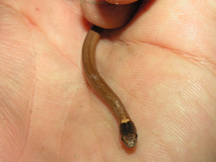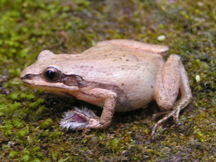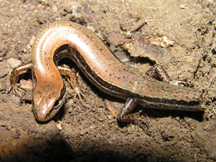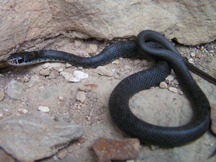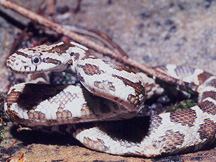
4-10-04
Trip Details
Start Time: 9:00 am
Weather: Mostly cloudy. Low wind. High of about 65 degrees.
Location: Johnson County, Illinois.
Herpers: Mike Pingleton, Jeff LeClere, Jim Scharosch & Matt Ricklefs
Quote of the day: “Salamander Dreams”
This was day three of the Illinois trip. It was pretty cloudy, and we had made the call the night before to go to another spot that Mike knew. It was fairly cool that morning, around 53 degrees, but we were looking at a high of about 65 – 70 degrees. There was a chance of rain in the afternoon, we just weren’t sure when that would end up being. So we set out. On the way out we found about a four foot long Diamondback Water Snake DOR (dead on road) that Mike wrapped up for some colleagues of is. This one looked like it had spent its time in a small pond not far away and just picked the wrong time to cross the road. As we stopped to go back to ID this there was another car that looked like it was going to swerve to hit it until they saw it was dead. We might have been wrong, but it sure looked like it. It would be nice if people would take the time to avoid these when they could…
The first live find of the day was a juvenile Northern Fence Lizard (Sceloporus undulatus hyacinthinus). It was cold. It looked like it was dead, but after a little video, I made a little area for it to go back under some wood. Once it new it had an out it scampered on under. We had all spread out to cover more ground, but were within earshot. A few minutes later and we had something we were hoping to find – a Spotted Salamander (Ambystoma maculatum).
We all re-grouped to take a look. It was about five inches long and in good shape. It was very cooperative, but then again it was a little cool even for salamanders. It must have had plenty of water. Although it did not move too much or too fast it did manage to pee quite a little puddle in Mike’s hand. Ah, the joys of herping. After a few minutes of admiring and documenting this “little plumper” we let it go back under its log.
We took a little break to talk and re-group. I was close by a cement “thing” with a liftable metal top. Of course any of us close by would have lifted this to look inside, but I was lucky enough to be the closest. Like opening a present I discovered our first snake of the day. Coiled loosely under the metal, and on top of a wood platform, was a Black Rat Snake (Elaphe o. obsoleta).
It was a nice sized one, about three feet long. Considering they are one of the larger colubrids in the US and it is fairly common to find six-foot long specimens, this one wasn’t huge. It was also in pretty good shape. It had quite a bit of yellow patterning on it, but the black was very black. Black Rats can be pretty beat up at times due to the fact that they can be found in just about any pile of junk or habitat within the stronghold of their range. This one had only one small ding on it and even that was not really noticeable except on close examination. We had commented before on the weather of the previous day having an impact on the next day’s herping. The day before it was 70 and sunny and perhaps this snake found this for cover the night before and held tight under the coolness of this chilly day. As Mike said though “Snakes are where you find them”. This may seem obvious or Yogi Berra-ish, but it is true. Sometimes you think you have a perfect day or area and you strike out. Some days it’s not very nice out and may not seem like a good area, and you find cool things. Luck plays a big part in this. I had not done great at finding things the last two days, so I had a good start. It’s never a competition among friends and well-seasoned herpers, but when you have a dry spell you do feel a little out of sorts. As long as you are finding things you never complain.
We knew salamanders would be “on the menu” for the day and one particular species we hoped to find was “opacum”, otherwise known as the Marbled Salamander. Mike had a “hot spot” for these in another area but did say they had been found where we were. Again Mike delivered as not soon after talking about this Mike shouted “opacum” and we had our first Marbled Salamander (Ambystoma opacum).
This was even cooler that I expected. These are awesome little salamanders. This one had an even mix of the black with the white across the back. This one also was in good shape. The area we were in offered a mix of woods and marsh with an area to walk in between. Obviously the herps we were finding had a lot of food. This one was about four and a half inches long. We took a while to admire and document this little guy then moved on to find what else may be out. Moving on we found… another Marbled Salamander.
This one had more concentrations of white in very cool bone-like markings across it back. This one was about the same size as the first one. Again we moved on after a while of documenting.
We then found a Five-Lined Skink (Eumeces fasciatus), a female.
You can tell the females once they are adult sized, as they are all brown. Males will develop a red/orange patch by the jowls, which gets brighter during the breeding season. As it was cool, this one cooperated pretty nicely. We did take some time to document this one briefly, then moved on. Of course when we put it down it seemed to hold tight, but bolted when the camera was ready. Oh well, que sera, sera.
Next on the list was a good-sized Slimy Salamander (Plethodon glutinosus).
In this area, the ranges of the Northern and Mississippi Slimy Salamander are close, but Northern seems to be more close to where we were. This one was a good five and a half inches long. The name “glutinosus” refers to the sticky glue-like substance secreted from these salamanders when alarmed. It is quite sticky and once set needs to wear off unless a detergent of some kind is used. We took pics and moved on. We had only seen one snake so far but that soon changed.
We also hoped to find a king snake in this area. Mike refers to them as the “Shawnee king”; this area shows the intergrade between the Speckled and Black King Snake species (Lampropeltis getula holbrooki x nigra). Mike again came through and near a pile of logs found one out sunning.
This one was about two feet long and pretty beat up. It had a lot of blisters on its skin and a big “garf” on the side of its face. It was also pretty thin. This can be a sign that overwintered in a wet hibernaculum. When documenting we do get all sides, but usually post the “good side”. It is good to document however. When you field herp you get to see first hand the different challenges these animals must face. You run across all kinds of interesting scars and marks and you ponder what may have happened. This is another good argument for keeping captive bred herps. They are specific to what color and markings you think you like the best and are flawless as long as you watch what you are buying or buy from reputable dealers. This king did pose nicely, and after documenting we moved on.
Marbled and Spotted Salamanders are in the Mole Salamander family and so far this day, we had seen a lot of them. Next, we found a Smallmouth Salamander (Ambystoma texanum).
This is identical in build as the Spotted and Marbled and was about the same size – four and a half inches long. This was the first time that Mike had seen a Smallmouth Salamander in this location. These are not as striking as the other species we had found but pretty in its own way with a bluish-black background with light bluish-grey lichen markings on its sides. They do have smaller mouths in comparison to the other species found this day. All of these salamanders are fairly slow moving, but when we allow them to go back under their logs they can move pretty quick. At this point it was 12:10 pm. We took a little extra time documenting this one then moved on.
The next find was another Marbled Salamander.
This one also had quite a high concentration of white. Mike informed us that females tend to be darker and males do tend to have more white. Herping with Mike and Jeff is cool as both have a lot of knowledge of herps. It was getting a little warmer and sunnier out now. As this was the third one this day we took some pics and moved on.
We were finding herps now at a rate of about one per every ten minutes. You can’t beat that. I had used up quite a bit of video, not that I am complaining. This was one of the better days we had had overall for total species. I had not found anything for a while, but I scored next.
It was small, but it was another species that Mike commented that they had not found in the area – A Western Smooth Earth Snake (Virginia valeriae elegans).
This one was about six inches long. I always enjoy finding these small snakes. There are a lot of small species that go unnoticed or unappreciated in the shadow of the larger more impressive species. We all appreciated this find though. This is a very nondescript snake with a greyish-brown top and whitish colored below, but still unique in this coloration and very cool. This one actually posed pretty nicely. We had discovered a new technique for posing. The salamanders tended to be less threatened when we use small twigs to move them into place as opposed to our fingers. This allowed us to move them around a little better and we applied this successfully to this small snake. We took a little extra time documenting this then moved on again.
I walked a little further and tucked away nicely by a log with some leaves for color was an Eastern Box Turtle (Terrapene c. carolina).
This one had a lot of red on it face with a built up cusp on its upper jaw that was contrasted in an orange/cream-white color. Box turtles often close up their shell as you might expect, so we did not bother this one so we could get some face shots. It posed nicely as long as we did not bother it. Eastern and Three-Toed box turtles tend to be highly variable in coloration both in the body and shell. Ornate’s for instance tend to be variable within the amount of yellow. Box turtles are always fun to find. They, like the salamanders, are just kinda dopey looking. You just gotta love them. We got our pics, put it back in its hiding place and moved on.
Next we found a Ringneck Snake.
This was worth documenting as it was all yellow below with little marking. These do look like most ringnecks we find in general description, but on close examination there are some noticeable differences. This is an intergrade area of the Prairie, Northern & Mississippi species (Diadophis punctatus arnyi x edwardsii x stictogenys). After some shots we moved on.
Mike had the next and smallest find – an eft phase of the Central Newt (Notophthalmus viridescens louisianensis).
This one, at about two inches, was smaller than its scientific name is long. The eft phase of newts is between the larval and adult stage. They spend time on land before returning to a more aquatic existence as adults. This one was brownish above and orangish below. It did take a little more time to document, as it was so small. We joked a little with movie references “Central newts, very dangerous”, “Bad newts”. These references are from Raiders of the Lost Ark if you are wondering. Mike followed this up with his own original, “Do you want the good newts or the bad newts?”. He was on a roll. On that note we moved on after letting this little one go about its business.
The next find was, yes, another Marbled Salamander. Wow, this was something else. This one had about an even mix of black and white. This was again about the same size as the others. More pics and we carried on.
Jim was getting a little discouraged, as he had not found much. He was to get the next big score. He saw some movement and made a dash for it. What he grabbed and what he saw turned out to be two different things. He saw a Shawnee King; he grabbed a large Yellowbelly/Copperbelly Water Snake (Nerodia erythrogaster flavigaster x neglecta).
It turned out that under a log were two water snakes and a king snake. Jim had seen the king, but when he moved for it it moved and spooked a water snake.
The other water snake was holding tight. With a cooperative effort we got all three. The larger water snake was about four feet long. The smaller was about three feet and the king snake was also about that size. This king was in much better shape and was very pretty with no bad scars, and more yellow than the previous one.
All behaved fairly nicely and we got some good pics. We spent a decent amount of time with these, then let them go back to their log.
Jim got the next find, an Eastern Garter Snake (Thamnophis s. sirtalis).
This one was very pretty with a lot of yellow, a very olive head and nice blackish markings by its neck. It was about eighteen inches long. It was 3:08 pm now and starting to sprinkle out a little. We knew rain was coming and were trying to get as much time in as we could. At some point recently, the garter got a tiny cut that bled a little, so if you see any red in the pics that’s the deal. The bleeding stopped after a little while. Jim was also to have the same problem shortly. We did take some time to get some nice pictures and then moved on.
The next find was an Eastern Ribbon Snake (Thamnophis s. sauritus).
In this part of the state you find the eastern as distinguished by the separation of spots on the top of the head. This was a small one at about ten inches long. It had very defined markings and a very cream belly with some cool peach color on its sides. Almost right next to where we were documenting this one Jim found another water snake.
This one was much grumpier and managed to get quite a few good bites on Jim. Any blood you see in these pics is Jim’s. Once was a good raking bite that required a band-aid later as it did not want to stop bleeding. Jeff also found another large water snake a few feet from this location also.
It was also not in a good mood, and wanted to bite.
It was getting late and we wanted to go to another location, so we left where we were. We stopped and got a late lunch at a local convenience store and waited out a short rain shower. It was getting really late, but we had one other place and decided to tough it out.
On the way was a glorious junk site. Junk of all kinds, a water source, some cover, some field, it was as good as it gets. It did look like it was used by other herpers, as the junk was a little too well placed and much was fairly new. Other people must be doing some modifications. It was sprinkling on and off still. We only found one thing, but it was a nice one. It was a beautiful Shawnee king.
This one was a good three and a half feet long, no blemishes and in good shape. It had a lot of yellow and some very defined chain-like markings. It was under a section of old camper wall. This snake did not want to sit still, and the rain made pics difficult. It was a bit grumpier and did coil and strike and tail rattle a bit. After a little while it did go into “coil and hide” mode and we could handle it and move it around to take a good look. With the rain it did wash it off so it was even more bright and cleaner than what would be usual. This was a beautiful specimen and after some time getting the best shots we could, we moved on and let this one go back to under its junk.
The first find at the new location was, yes, a Marbled Salamander. This one was a little darker. We were all getting low on energy, batteries and video/pic storage. This was a long day of documenting. We then found another Slimy Salamander also.
It was about 7:00 pm and the sky was getting dark and taking pictures was becoming difficult. We did manage to find something that Mike and his friends had not found in this area before, a Redbelly Snake (Storeria occipitomaculata).
This was a small one, about five inches long. We did get some pics and moved on as we were losing light fast.
The next find was out jumping around. A Western/Upland Chorus Frog intergrade (Pseudacris triseriata triseriata x feriarum).
This one was pretty chunky and most likely was a female with eggs. She was a good one and a quarter inches long. We did take some time to get some shots as she was a pretty example and then headed our way. Jim found a Ground Skink (Scincella lateralis) that was chilly enough to sit still for a photo.
It was missing the end of it's tail from a previous encounter with a predator of some sort.
Jeff found a very odd find next. It was a Northern/Southern Black Racer intergrade (Coluber c. constrictor x priapus).
This is not odd in and of itself, but this was a juvenile. No, that’s not the odd part either. This one was about seven inches long and had already developed almost its complete black adult color. Young racers of all kinds normally differ greatly from the adults. They have blotching and spotting, as you can see on this picture of a juvenile Yellow-Belly Racer, which would show a similar patterning. Even though it is a different species, they share the same patterning as juveniles. Besides the black it also had a beautiful hue and spots on the lower sides. This little one was very, very cool. We wondered if this was a melanistic example or if this is a unique feature to racers of this area. It would take an effort to find enough young racers to find out for sure. If anyone has any information on the coloration of juvenile black racers in lower Illinois let us know. We took as much time as we could, considering the darkening and rainy conditions. We were lucky, as we were on a bluff with an overhang that did provide some good cover. During documenting this one we also found a Cave Salamander (Eurycea lucifuga). A nice one about three inches long. Again, we were finding herps with great frequency. We were very glad even if it was late. It still amazes me that with such small legs these little salamanders can MOVE! After enough pics of the racer and the salamander we moved on to close to the end of the area we were looking around.
Not far away, Jim found a Midwest Worm Snake (Carphophis amoenus helenae). This one was small, about three inches long. It was now 7:15 pm It was about fifty-two degrees and rainy. This one we could hardly get pics of as it was so small and it was pretty dark out. We did get some video and started to move toward the end again. We kept looking though as we were still finding herps and often too. We did manage to find a good-sized Northern Fence Lizard (Sceloporus undulatus hyacinthinus) – a male. The color below was not too bright yet, but was noticeable. As I was videoing this, Mike found another Cave Salamander out and about. That was cool also. We were definitely nearing the end, but had one more surprise.
We were at the end of the area; we were getting ready for a short climb to get back to the truck. I passed a small rock face, but turned around to get my bearings when I noticed something beside me – a juvenile Black Rat Snake (Elaphe o. obsoleta).
(Note: Thanks to Mike Pingleton for the photos, my camera wouldn't autofocus in the dark - jim)
Like the racers, the pattern of many juvenile rat snakes, including Black rat snakes, differs greatly from the adult pattern. This one was only about eight inches long. It held tight to the rock face, but decided it may want to go back in its crack so I grabbed it. This one had a lot of grey and longitudinal markings on it. It posed pretty nicely and reared up and tail rattled when we repositioned it. I was glad I noticed this snake, as Jeff was right behind me. If I had not spotted it and Jeff had seen that I had passed it by, I would never have heard the end of it. It was 7:27 pm now. This was a good end to the day. We had just been talking about snakes in cracks in bluffs and low and behold there one was! As I write this I have the hindsight to know that a few weeks later we would find quite a few Black Rats in Iowa in bluff cracks, but that is another posting. We let this one go back to the crack it was heading for and in it went. Off we went to the truck.
One more find – a Fowler’s Toad (Bufo fowleri). This is another re-class from the original Bufo woodhousii fowleri. This Fowler’s Toad was very cool and tucked under on itself, and did not budge. Mike had seen this out and about and as we were close to the truck we used the lights to get the best look we could. Still though, another species to document for the day! It was now completely dark and even if we wanted to continue it was too dark. We were at the truck and ready to go so off we went.
A happy long day of herping.

